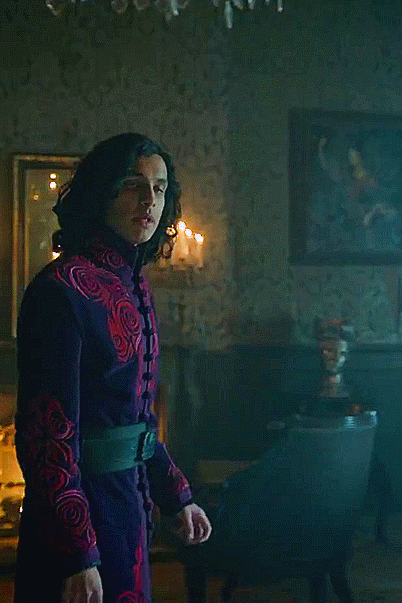Canon to Costume
Crafting the Kefta for Shadow and Bone
One of the factors about Leigh Bardugo’s Grishaverse which captivates us is, of course, the Grisha. And what is a more iconic symbol of Grisha than the kefta?By the time the rights had been sold for a screen adaptation of Shadow and Bone, kefta already had a significant reputation within the Grishaverse fandom as embodiments of the identity and power of Grisha. This meant that there was a certain amount of pressure to get them right!
But the Shadow and Bone costume design team were up to the challenge. Led by the talented Wendy Partridge, the team undertook the task of honouring the way kefta are represented within the books while still creating practical, wearable costumes for the actors.
Join us in delving into the importance of kefta within the universe, as well as the work of the costume designers who brought the kefta to amazing life in Shadow & Bone on screen!
Hang On—What is a Kefta?
Cultural Significance
You might have thought the kefta is just a fashion statement which any Grisha could throw on to indicate their type, but that isn’t the case! Kefta are actually military vestments worn by members of the Second Army—for combat, training, formal events and in their day-to-day life—with their type delineations used to help organise them within the ranks.Design Features
Kefta are best described as robes or coats worn over the clothing. They’re quite long, nearly to the floor, and consist of several fabric panels secured with hidden buttons down the front. There is ornate embroidery at the cuff and hems of every kefta to indicate the wearer’s Grisha type (as we’ll explain in a moment!), as well as variations based on season and use. One of these variations is a bulletproof kefta made for combat.Turning Canon into Costume
Despite the series’ historical inspiration, with Ravka drawing upon many Russian and Eastern European traditions, kefta are by no means historical garments. The costume designers still needed to craft them to fit the atmosphere, universe and unique specifications of the show.This helped the team in some ways and made things more complex in others. As Partridge explained in an interview, the Grishaverse is still a fantasy world, which meant they could enjoy some creative liberties. However, the descriptions of the kefta in the books were very clear as well, which meant there was little room for deviation.
Shadow and Bone “had the flavor of a period show, the flavor of Russia,” Partridge said. “But [it] definitely has its own look. It’s not something that we’d really seen before.”
The Many Colours of the Kefta
By Type and Order
You can spot each of the Grisha Orders by their embroidery and colours. Corporalki wear red kefta, with black embroidery for Heartrenders and grey for Healers; Etherealki wear dark blue, with pale blue for Tidemakers, red for Inferni and silver for Squallers; and Materialki wear purple, with grey for Durasts and red for Alkemi.Servants in the Little Palace are also able to be identified by their white keftas embroidered in gold.
There are also a few noteworthy kefta outside of this usual list, such as the Darklings black on black and Genya Safin’s dark blue on red. Alina Starkov was also encouraged by the Darkling to wear a gold on black kefta, but she insisted on wearing blue with gold embroidery in solidarity with the other Etherealki instead.
Designing It Right
Weaponised Embroidery
One of the required design elements for kefta on the show was their embroidery, which needed to be designed from scratch for every Grisha type.Historical research was of little help in this respect. The costume designers generally drew on inspirations from Slavic fashions from the 1800s, but the embroidery used during this time was generally curly and soft, in opposition to the aims for the costume. “I didn’t want that to be the style for the keftas because these were military uniforms,” Partridge explained. “[T]his wasn’t a frivolous ornamentation.”
And so Partridge instead opted for a design which more closely reflected the universe:
“I went with a much more … almost modern graffiti style of graphic so that everything ended up in a point, everything was sharp, everything was aggressive. Every flame that was in the embroidery or even for the Heartrenders, the ribs that came around—everything that came around ended in something pointy.”
Looking Bulletproof
Kefta designs also took their bulletproof fabrics into consideration. To represent this visually, Partridge conceptualised a thorny pattern which was printed onto all the fabrics prior to embroidery. She said:
“Everything has this very subtle texture to the fabric, and it meant that as they get shot and fight, their keftas were actually a form of armor. So that thorny and aggressive quality was brought through everything and allowed us to have something that gave us a look that wasn’t expected.”
As Shadow & Bone could still technically be classed as a period show, this design decision was also partially to ensure the series could appeal to a broader range of viewers without alienating younger audiences who wanted something modern: “I wanted it to feel fresh and alive the whole time.”
Time to Create
Actually creating the costumes was extremely labour-intensive. The show was being filmed in Budapest, Hungary; printing would be completed in another country before being shipped there for embroidery. This needed to be done by hand for every single kefta on the show.And this wasn’t just one kefta per actor, either! Separate kefta were made for different events—for combat, for parties—in a variety of sizes to fit their actors. This made it a huge job with over 250 kefta made from scratch, but in the end, we’d say that the attention to detail paid off to wonderful effect.
A Moment for the Fans
The Grishaverse has an immensely committed, passionate fandom, and throughout the years this has resulted in some absolutely incredible fan-made kefta designs! Go to any fan convention and you’re likely to see somebody wearing their own handmade version.Try It Yourself!
If you ever want to make a kefta of your own, why not give it a try! You can find plenty of tutorials by searching online or on social media, where fans will often share their own results and methods. This thread on Reddit includes a really handy guide made by _River_Song_.Another resource we recommend is Popverse’s kefta tutorial, which includes some great resources for beginners and those with more experience!
What do you think?
Type biases aside, do you have a favourite kefta design? (I have to say, my personal favourite is the way they made the embroidery on the Durast kefta look like the antlers of Morozova’s stag, which was perfect for David!)And would you ever make your own kefta, or have you tried? If you do/have, you should come and show us your results—we’d love to see them!

WoGV







